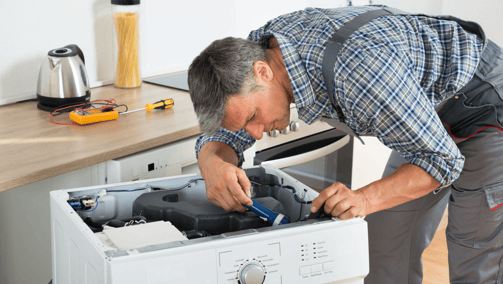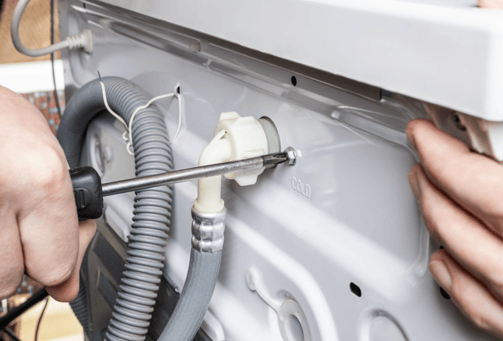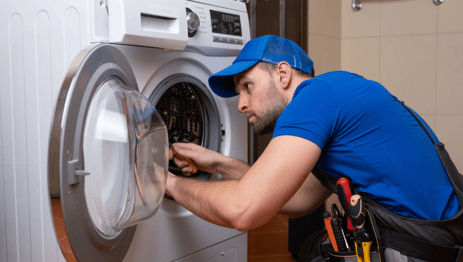Washing Machine Spin Repair Dubai
Washer not spinning? We fix broken belts & motor issues in Dubai. Extended warranty on all repairs - book now!
REPAIRS
4/20/20258 min read
Understanding the Physics of Washing Machine Spin Cycles
The physics underlying washing machine spin cycles revolves primarily around the principles of centrifugal and centripetal forces. When a washing machine enters its spin cycle, the tub rotates at high speeds, with the objective of expelling water from clothing. The essential mechanism at work here is the balance between these forces, which collectively facilitate effective water removal.
Centripetal force acts as the inward force that keeps the water and clothes pressed against the sides of the rotating drum. In contrast, centrifugal force, which is often perceived as an outward force, causes the water to move away from the center of rotation. As the drum spins faster, the greater the centrifugal force applied to the water, ultimately pushing it through the perforations in the drum and expelling it out of the drainage system. This intricate dance of forces is essential for achieving thorough spin efficiency and, consequently, superior drying results.
The significance of spin speed cannot be understated. Generally, faster spin speeds lead to more effective water removal, effectively reducing drying time and improving the overall efficiency of the washing process. Common spin speeds range from 600 to 1400 RPM (revolutions per minute), with higher speeds being ideal for durable fabrics and lower speeds better suited for delicate materials. Understanding these parameters enables users to select optimal spin settings tailored to the type of load, ensuring that garments are efficiently cleaned and dried.
Various spin cycles are designed to cater to different fabrics and washing needs. For instance, a gentle spin may be employed for delicate items, while a high-speed program is typically reserved for sturdy textiles. Familiarity with these options allows consumers to maximize their washing machine's performance while prolonging the lifespan of their garments. By comprehending the physics of washing machine spin cycles, users can make informed decisions that lead to enhanced laundry outcomes.
Impact of Sand Contamination on Dubai’s Drainage Systems
The unique environmental conditions in Dubai, characterized by its arid climate and sandy landscapes, significantly impact the functionality of drainage systems throughout the city. One particular challenge that homeowners face is the contamination of these systems with sand. As sand particles infiltrate drainage pipelines, they can cause blockages that hinder the effective flow of water. This not only leads to inefficiencies in the drainage systems but also poses a risk to household appliances like washing machines, especially during their spinning cycles.
When sand accumulates within the drainage systems, it can lead to an increased likelihood of overflow or backflow issues. For washing machines, this can result in inadequate drainage of water post-wash cycle, leaving excess moisture in the drum. Such complications can lead to poor spinning performance, as the machine struggles to expel water effectively, ultimately hindering the laundry cleaning process. Furthermore, the presence of sand can contribute to wear and tear within the washing machine components, leading to more frequent malfunctions and costly repairs.
To mitigate the impact of sand contamination, homeowners can adopt several preventative measures. Firstly, routine maintenance of drainage systems is essential. Regular inspections can help identify and address blockages before they escalate. Additionally, installing filtration systems that capture sand particles before they enter the drainage network can significantly reduce contaminants reaching washing machines. Another approach involves the proper landscaping of yards and gardens to minimize sand runoff into drainage systems during wind or rain events.
By taking these proactive steps, residents of Dubai can not only preserve the integrity of their home appliances but also enhance the efficiency of the overall drainage system, ensuring a smooth and effective functioning in households throughout the city.
Motor Bearing Replacement Techniques
Motor bearings play a crucial role in the functioning of washing machines, as they facilitate smooth rotation of the motor shaft. Over time, these bearings can wear out due to continuous friction and load, resulting in inefficiencies in the spin cycle and potentially serious mechanical issues. Identifying the signs of failing motor bearings is essential; common indicators include unusual noises during operation, excessive vibration, and leaks of lubricants. If these symptoms are observed, it is advisable to consider a replacement to maintain optimal washing machine performance.
Before starting the bearing replacement, gather the necessary tools: a socket set, a screwdriver, a bearing puller, new motor bearings, and safety goggles. Begin by disconnecting the washing machine from the power supply and turning off the water inlet to ensure a safe working environment. Next, remove the back panel of the machine to access the motor. Carefully unscrew any components obstructing access to the motor, including belts or couplers.
Once the motor is visible, detach it from the machine by unscrewing it from its mounting. Using a bearing puller, carefully extract the worn bearings from the motor's housing. Clean the area thoroughly to remove any old lubricant or debris before installing the new bearings. Align the new motor bearings properly, ensuring a snug fit into the housing. During this process, take care to lubricate the bearings lightly to enhance performance and longevity.
Finally, reinstall the motor into its original position and reattach any components that were removed. Connect the washing machine back to the power supply and run a test cycle to ensure everything is functioning correctly. By following these techniques and safety precautions, motor bearing replacement can be executed effectively, thus prolonging the lifespan of the washing machine.




Load Sensor Calibration Process
Load sensors play a pivotal role in the functionality of washing machines, as they are responsible for measuring the weight of the laundry load. This measurement allows the washing machine to optimize the spin cycle, ensuring efficiency in both energy usage and water consumption. When functioning correctly, load sensors allow the machine to adjust its spin speed and duration based on the size and weight of the load, resulting in improved washing performance.
Accurate calibration of load sensors is crucial for achieving optimal machine performance. When these sensors are miscalibrated, they may not accurately detect the weight of the laundry load, leading to improper spin cycles. For example, if the machine underestimates the load, it may spin too aggressively, causing wear and tear on garments or even damaging the machine itself. Conversely, an overestimation can result in inadequate spin cycles, leaving clothes excessively wet and requiring additional drying time.
To properly calibrate load sensors, one should first prepare the washing machine and ensure it is in a stable position. Begin by loading the machine with a standard weight, typically recommended by the manufacturer, to ensure consistency. Next, access the service mode of the washing machine—this is usually achieved by following specific button sequences as outlined in the user manual. Once in service mode, initiate the calibration process, which could involve running a specific test cycle that helps the machine and its electronics recalibrate the sensors accordingly.
Following the calibration process, it is essential to conduct multiple test washes, progressively increasing the load size to verify that the sensors correctly register the weight. If issues persist or if the machine continues to provide inconsistent results, seeking professional repair services may be beneficial. Proper load sensor calibration not only optimizes performance but also saves on energy costs and prolongs the lifespan of the washing machine.
FastRepairs | Vibration-Reduction Upgrades for Your Washer
When it comes to addressing common issues faced by washing machines, excessive vibrations during the spin cycle can be particularly disruptive. FastRepairs has developed advanced vibration-reduction upgrades designed to enhance the stability and performance of your washing machine. These upgrades utilize cutting-edge technology that targets the root causes of vibrations, ensuring a quieter and more efficient operation.
The foundation of our vibration-reduction technology lies in precision-engineered components that are integrated into the washing machine’s structure. This includes reinforced mounting systems and dynamic dampening units that absorb and redistribute the forces produced during high-speed spins. By effectively minimizing vibrations, our upgrades not only lower noise levels but also improve the overall stability of the washer, leading to more effective washing cycles.
Customers who have invested in our vibration-reduction upgrades have reported significant improvements in their washing experience. For instance, one client noted that their previously noisy machine became nearly silent during operation after the upgrade, allowing them to run laundry at any time of day without disrupting their household. Another customer shared that the enhanced stability contributed to more effective water extraction, resulting in less drying time for their laundry.
In addition to reducing noise and improving spin stability, FastRepairs’ upgrades also contribute to the longevity of washing machines. By preventing excessive vibrations, the risk of mechanical wear and tear is substantially diminished, ensuring your appliance remains in optimal condition for years to come. The effectiveness of these upgrades has established FastRepairs as a trusted provider of washing machine solutions in Dubai, helping countless customers enhance their laundry appliances with reliable performance and efficiency.
Certified technicians with extensive experience.
24/7 emergency services.
Transparent and competitive pricing.
Let’s Get Started
Visit FastRepairs.ae or call us at +971528913379 to schedule your repair today. Experience seamless, stress-free service with FastRepairs.ae!








Maintenance Checklist for Optimal Washing Machine Performance
Maintaining a washing machine is crucial for ensuring its optimal performance and longevity. By routinely performing maintenance tasks, users can minimize the risk of spin issues and enhance the efficiency of their appliances. Therefore, it is beneficial to have a comprehensive maintenance checklist that outlines essential tasks to keep washing machines running smoothly.
Firstly, regular cleaning of the filters is vital. Clogged filters can impede water flow, which directly affects the machine's spinning capabilities. It is advisable to remove and clean the lint filter every few months, ensuring that debris and detergent residues are cleared away. Additionally, inspecting the inlet filters on the water hoses is important to prevent restrictions that could hinder water supply.
Next, hose inspection should be part of the maintenance routine. Users should regularly check for any signs of wear or damage, such as cracks or bulges. Replacing damaged hoses promptly can prevent leaks and ensure consistent water flow, which is essential for efficient spin cycles.
Another critical aspect is checking the machine's drum for any foreign objects, such as coins or small clothing items. These objects can disrupt the balance during the spin cycle, leading to potential damage. A quick visual inspection before each wash can save users from future repair costs.
Lastly, monitoring the motor's performance can provide insights into the machine's overall health. Listening for unusual noises during operation or noticing any changes in spinning speed can be indicators of underlying issues. If any inconsistencies are detected, it is recommended to consult a professional for further evaluation.
To assist with maintaining washing machines, a downloadable PDF checklist is available, summarizing these maintenance tasks. By utilizing this checklist, readers can ensure proactive care for their washing machines and avoid spin issues before they arise.


FastRepairs.ae
Reliable repair solutions for your needs.
Contact
Contact Form
contact@fastrepairs.ae
© 2024. All rights reserved.
This website is developed and managed by PranveraSolutions.
PranveraSolutions is not affiliated with fastrepairs.ae and is not responsible for any content, services, or actions of fastrepairs.ae. Any issues or legal matters should be directed to fastrepairs.ae
Hours
Monday, 9:30 am–8 pm
Tuesday, 9:30 am–8 pm
Wednesday, 9:30 am–8 pm
Thursday, 9:30 am–8 pm
Friday, 9:30 am–8 pm
Saturday, 9:30 am–7 pm
Sunday, 9:30 am–7 pm
Blog


